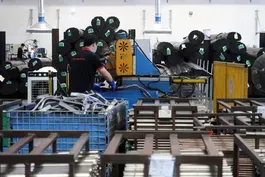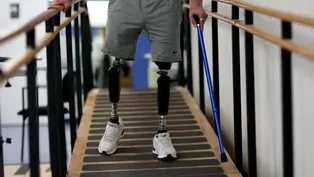
Digital tool gives a groundbreaking new look at the Titanic
Clip: 4/13/2025 | 4m 31sVideo has Closed Captions
Digital technology gives a groundbreaking new look at the Titanic’s wreck site
This week marks 113 years since the sinking of the Titanic. Now, there’s a new tool to explore it: a full-scale digital twin of the wreckage created with cutting edge 3D scanning technology. That’s the subject of a new National Geographic documentary, “Titanic: The Digital Resurrection.” John Yang speaks with Titanic analyst Parks Stephenson for more.
Problems with Closed Captions? Closed Captioning Feedback
Problems with Closed Captions? Closed Captioning Feedback
Major corporate funding for the PBS News Hour is provided by BDO, BNSF, Consumer Cellular, American Cruise Lines, and Raymond James. Funding for the PBS NewsHour Weekend is provided by...

Digital tool gives a groundbreaking new look at the Titanic
Clip: 4/13/2025 | 4m 31sVideo has Closed Captions
This week marks 113 years since the sinking of the Titanic. Now, there’s a new tool to explore it: a full-scale digital twin of the wreckage created with cutting edge 3D scanning technology. That’s the subject of a new National Geographic documentary, “Titanic: The Digital Resurrection.” John Yang speaks with Titanic analyst Parks Stephenson for more.
Problems with Closed Captions? Closed Captioning Feedback
How to Watch PBS News Hour
PBS News Hour is available to stream on pbs.org and the free PBS App, available on iPhone, Apple TV, Android TV, Android smartphones, Amazon Fire TV, Amazon Fire Tablet, Roku, Samsung Smart TV, and Vizio.
Providing Support for PBS.org
Learn Moreabout PBS online sponsorshipJOHN YANG: This week marks 113 years since the sinking of the Titanic.
A tragedy that's captivated generations.
It's been the inspiration for three big movies.
Now there's a new tool for exploring it.
A full scale digital twin of the wreckage created with cutting edge 3D scanning technology.
That's the subject of a new National Geographic documentary, "Titanic: The Digital Resurrection," which is streaming on Hulu and Disney Plus.
Earlier I spoke with Titanic analyst Parks Stevenson.
I asked him to compare the virtual experience with the real life visits to the wreckage in a submersible.
PARKS STEPHENSON, Titanic Analyst: In a submersible, your view to the outside world is like a 7-inch viewport.
And your light only carries less than 100 meters in front of you.
So you only see the wreck a little bit at a time.
To see it all like this, well lit up in context, you can see off into the distance that's a view that you never have at the wreck site.
JOHN YANG: Did anything surprise you about what you saw on the digital twin?
PARKS STEPHENSON: Everything I saw surprised me.
My experience has been through dives, through studying digital imagery captured by cameras.
I've seen the wreck in context, put together in the early days by artists who painted the wreck after they studied all of the imagery, but that's all involving human intervention.
This, however, is completely data driven.
And so now I'm seeing the wreck in its context for the first time.
JOHN YANG: What were some of the biggest questions that got answered with this new way of looking at it?
PARKS STEPHENSON: On the first render that was sent to me was of the stern.
I've always tried to explain why the stern section is in such worse condition than the bow section.
And in this first render, it was depicted so accurately that I could tell part of what we learned Tthat the stern spiraled down, the rudder dug in, and the whole stern section tweaked.
When it tweaked, all those connections, the decks and the frames and the shell plating, they were all stressed.
Some gave way immediately.
But as we've learned from experiments held by the wreck, anything that was tweaked, corrosion is accelerated.
And that's why she's now flattened in the middle, the stern section is.
That was just one glance, and to my engineer eye it's what I needed.
JOHN YANG: And you say there's some new questions that arose.
What are some of those?
PARKS STEPHENSON: People have questions about how long the Rhett's going to be with us.
And I've heard some of the more dire predictions about she's going to be gone in 20 years or so.
That's not true.
The wreck will be here long after you and I are gone, but it's not going to look like it does now.
There are some of the lighter structures that will erode or corrode within the next few years or so.
With every bit of corrosion, it may open up new possibilities to penetrate and look inside the wreck.
For instance, in the stern, I'm seeing potential new penetration points so where we can go inside the stern for the first time.
In n the bow, the skin of the ship, it's pulled away from the skeleton enough that we could probably now get inside of there.
So we may be able to get down into the interior boiler rooms, which we've never been able to get into before.
JOHN YANG: Beyond sort of answering these mysteries of history, are there lessons to be learned that could be used today, that could be important today?
PARKS STEPHENSON: The Titanic story was originally built off of a oral history.
All we had were the statements of the survivors.
And as I've interviewed participants in historical events over the years, I found that human memory is fallible.
So the narrative of Titanic, I think, is going to start changing as we get more and more stories out of the steel.
What I'm concentrating on right now is reverse engineering the breakup based on the evidence that we've documented on the ocean floor and find out exactly why she broke up.
The more I study the wreck and the pieces on the bottom, I'm finding more and more evidence that Titanic was actually well built, well designed, everything was done right, and yet look what happened.
That's the lesson from Titanic.
Don't assume that just because everything's going right, you've got everything figured out.
JOHN YANG: Parks Stephenson, thank you very much.
PARKS STEPHENSON: Thank you.
How China is responding to pressure from Trump as trade war brews
Video has Closed Captions
How China is responding to Trump as trade war brews (4m 30s)
How Telegram became a hub for hate crime and extremism
Video has Closed Captions
How the Telegram app became a hub for hate crime and radical extremists (6m 1s)
News Wrap: Russian strike on Sumy, Ukraine kill more than 30
Video has Closed Captions
News Wrap: Russian missiles kill more than 30 people in Ukrainian city of Sumy (2m 44s)
Why insurance companies are denying coverage for prosthetics
Video has Closed Captions
Why insurance companies are denying coverage for prosthetic limbs (5m 48s)
Providing Support for PBS.org
Learn Moreabout PBS online sponsorshipSupport for PBS provided by:
Major corporate funding for the PBS News Hour is provided by BDO, BNSF, Consumer Cellular, American Cruise Lines, and Raymond James. Funding for the PBS NewsHour Weekend is provided by...















